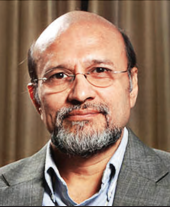Santosh Mehrotra
Biz@India
June 2017

SANTOSH MEHROTRA, Professor of Economics, Centre for Informal Sector and Labour Studies, Jawaharlal Nehru University
India needs to fix its skilling challenges by devising employer driven and industry-funded mechanisms, rather than through government-sponsored programmes, says Mehrotra.
Professor of economics at Centre for Informal Sector and Labour Studies, Jawaharlal Nehru University, Santosh Mehrotra, is the author of India’s Skill Challenges and member of the high-level Sharada Prasad Committee that recently examined the country’s technical and vocational education sector and optimisation and rationalisation of a large number of skill sector councils in the country. He talks to Biz@India about the state of skill development in India.
Is there a growing realisation of the importance of skill development and technical and vocational education training in India?
The National Sample Survey tells us that 10 years ago, just two pc of the entire workforce of 400 million workers in the country had received vocational education. This shockingly low figure reveals the utter neglect of vocational education since Independence. However in the last decade, there has been a remarkable shift in government policies, leading to far greater emphasis on skill development and Technical and Vocational Education Training (TVET). For the first time, the Eleventh Five Year Plan (2007-2012) had a separate chapter on skill development, which had been missing in the previous 10 plans. In 2012, when we were drafting the 12th Five Year Plan, I led the team on skill development. This lacuna was given due attention.
What were the reasons behind skill development being included in the policy framework?
After 2003-04, and 2011 in particular, the growth rate of the Indian economy increased sharply to touch 8.4 pc per annum average, the fastest growth till then.
Employers across the board felt the need to hire skilled people, but they were not to be found. One of the reasons why wages rose in that period in the organised and unorganised sectors was that people with relevant skills were not available, and so industry was willing to pay higher wages than before. Yet, India is still skilling far few people. Today, the share of skilled people may not be more than five pc. So, no huge change has occurred.
India has been revising its skilling target downward from 500 million to 400 million, and now the target is 150 million people by 2022.
First, we need to understand that the 500 million people training target for the 2012-22 period was an off-the-cuff number. It was arrived at with back-of-the-envelope calculations, a casual estimate made by late professor C K Prahalad of the University of Michigan, United States of America (US). That number by sheer repetition became the national policy under the United Progressive Alliance government headed by Prime Minister Manmohan Singh. It was silly and remains a silly number because the size of the Indian workforce itself was not 500 million. According to his assumption, everyone needs to be trained vocationally. That is not true. It does not work even in the industrialised countries.
The 500 million target was included in the skills policy of 2009, while the 400 million target appeared in the national skills policy of 2015. There is no difference between the two numbers. Both are gross overestimates. This is because we have to assume that 225 million farm workers in the country are unskilled and need to be skilled. Otherwise, we cannot reach the 400 or 500 million target. It is not logical or meaningful. Farmers need extension services and not skilling or training.
As director general of the research institute of the planning commission, I was appalled at these numbers. After going through the national sample survey, we concluded that we needed to train 200 million people between 2012 and 2022. This means that we have to train 20 million people per annum over 10 years. Even after the ramp-up of the system, India is probably skilling five to six million people only. India has a long way to go. The system needs to expand.
What are pillars of India’s TVET efforts to skill its millions?
They are Industrial Training Institutes (ITIs), secondary schools, 20 central ministries and private vocational training providers, funded and incubated by the National Skill Development Corporation (NSDC) since 2010, besides enterprise-based training.
There were 1,900 ITIs 10 years ago. Today, there are 2,400. There were 2,000 private ITIs 10 years ago. Today, there are 12,000, a six-fold growth. You can imagine what happens to quality. The supervising ministry does not have the capacity to regulate.
The National School Qualification Framework has finally introduced vocational education in schools for the first time. This is good because a high percentage of school students tend to drop out after completing eighth grade. If vocational education is offered, they may continue in school, helping them to enter the labour market.
The NSDC funded private vocational training institutes. In a real sense, it became a non-banking finance company. Mere managers entered the business of vocational training because large government funding was available. In 2009, only 16 pc of the registered enterprises were conducting training. Their proportion rose to 36 pc by 2014. These were large enterprises with financial muscle that undertook training. Usually small and medium enterprises do not undertake training.
India has more than a dozen skill development initiatives. Have they been able to deliver on the targets?
They are all government-driven and government-funded and hence, it is a supply-driven system. Now skills are not in demand. Then why are you supplying them? The quality is determined by the length of training, quality of trainers and whether industry is providing internship and experience during the training. Most trainers in India are poorly trained with little industry experience. So imagine the quality of skill training. The training duration of most courses is anywhere between one and four months. No industry experience is available. Just as ITIs have problems finding good trainers, so do private ITIs funded by NSDC.
In the absence of these three factors, imagine the quality of skill training. That is why we find industry rejecting them. This is reflected in the World Bank and the ‘Pradhan Mantri Kaushal Vikas Yojana’ data.
Where does India stand in terms of skilling today?
We cannot hope anybody to get quality skills based on three to four months of training. Also, Indian schools produce semi-literate, seminumeric and half-educated students who come for skill development. How can they get decent jobs?
Is employer-driven and industry funded skilling the way forward for scripting a successful skill story?
Vocational education will benefit the trainee and industry. So funding should come from employers.
Indian industry has been complaining about poor skill training…
Indian industries have been free riding on ITIs, IITs and IIMs, which are all government-funded. In East Asia or Europe, where the TVET is employer driven and industry-funded, skilling is demand-driven and quality and relevance are ensured.
What is the rationale behind the recommendation of rationalisation of several skill sector councils by the Sharada Prasad Committee, of which you were a member?
We have recommended that the sector skill councils, which were incubated by the NSDC, be rationalised. No country has 41 sector skill councils. We have allowed them to emerge without much logical basis. We have recommended the number should come down to 21 sector skill councils based on industrial classification in the annual survey of industries.
How do you see the Indian skilling story going ahead?
It needs to be fixed. We have to ensure a mechanism and means so that Indian industry has the skin in the game. I say this on account of evidence from 62 countries where industry makes a contribution to the skill sector fund that is used for training. This is the way forward. Of course, government funds will be needed for skilling those in the unorganised sector and ensuring equity.










